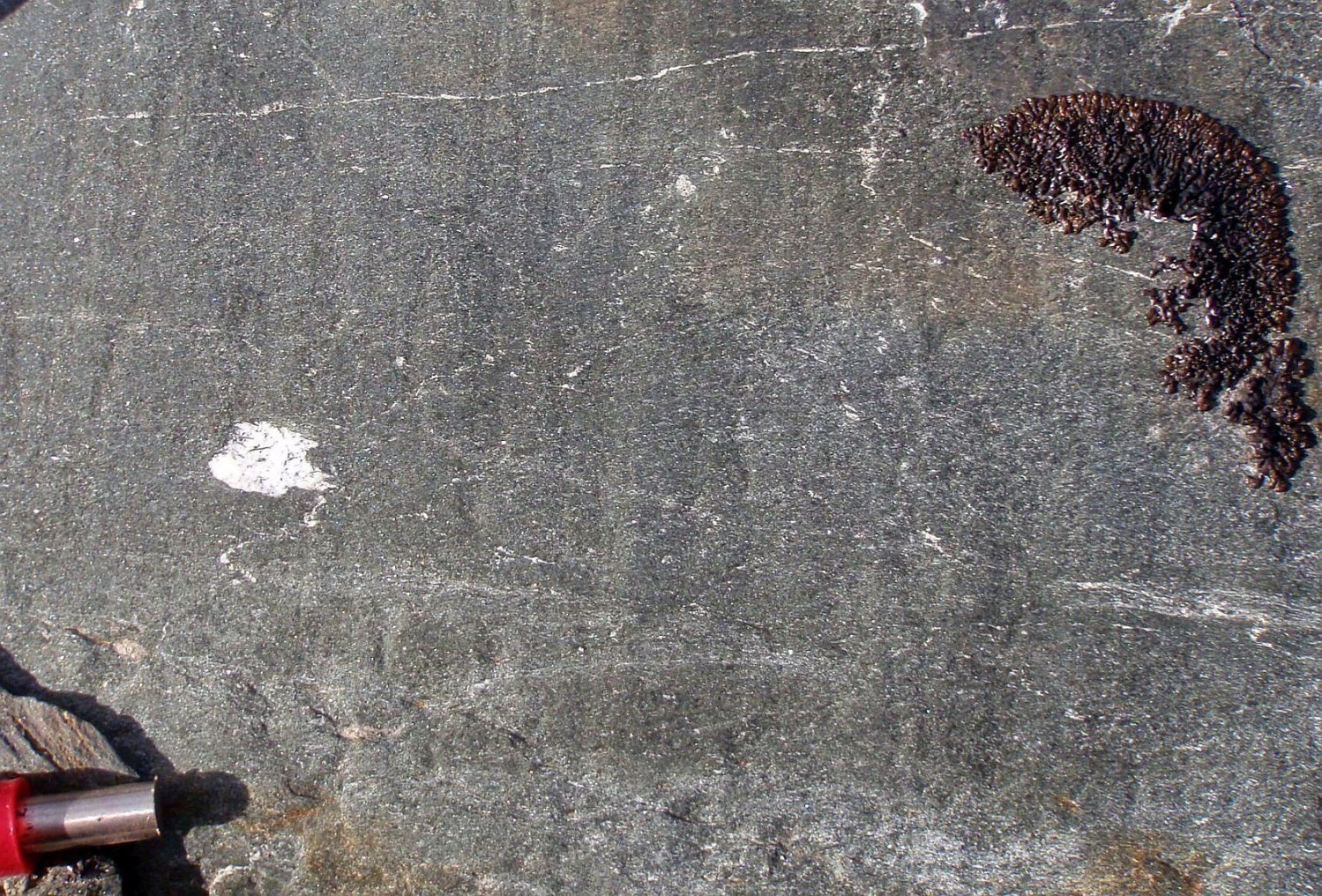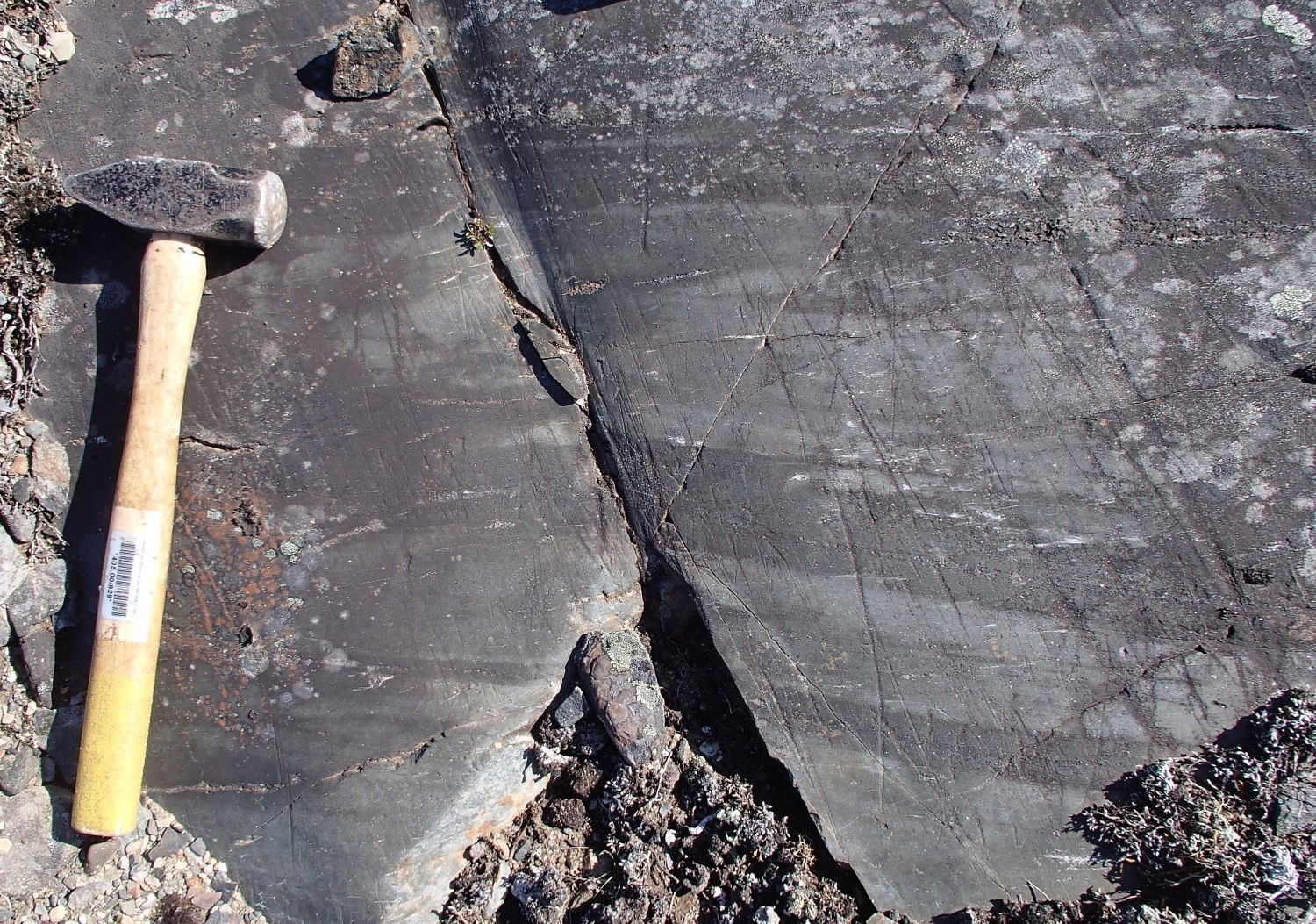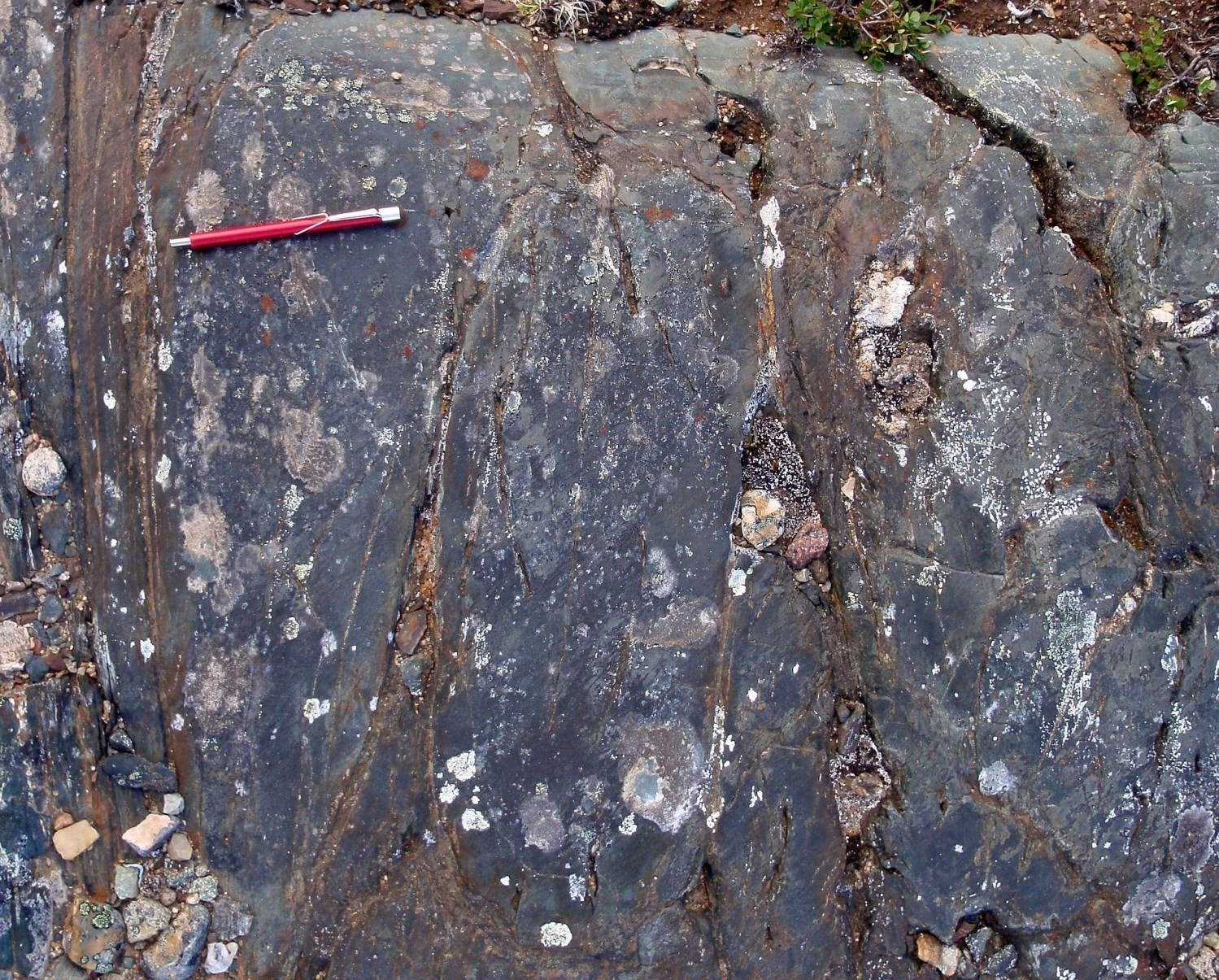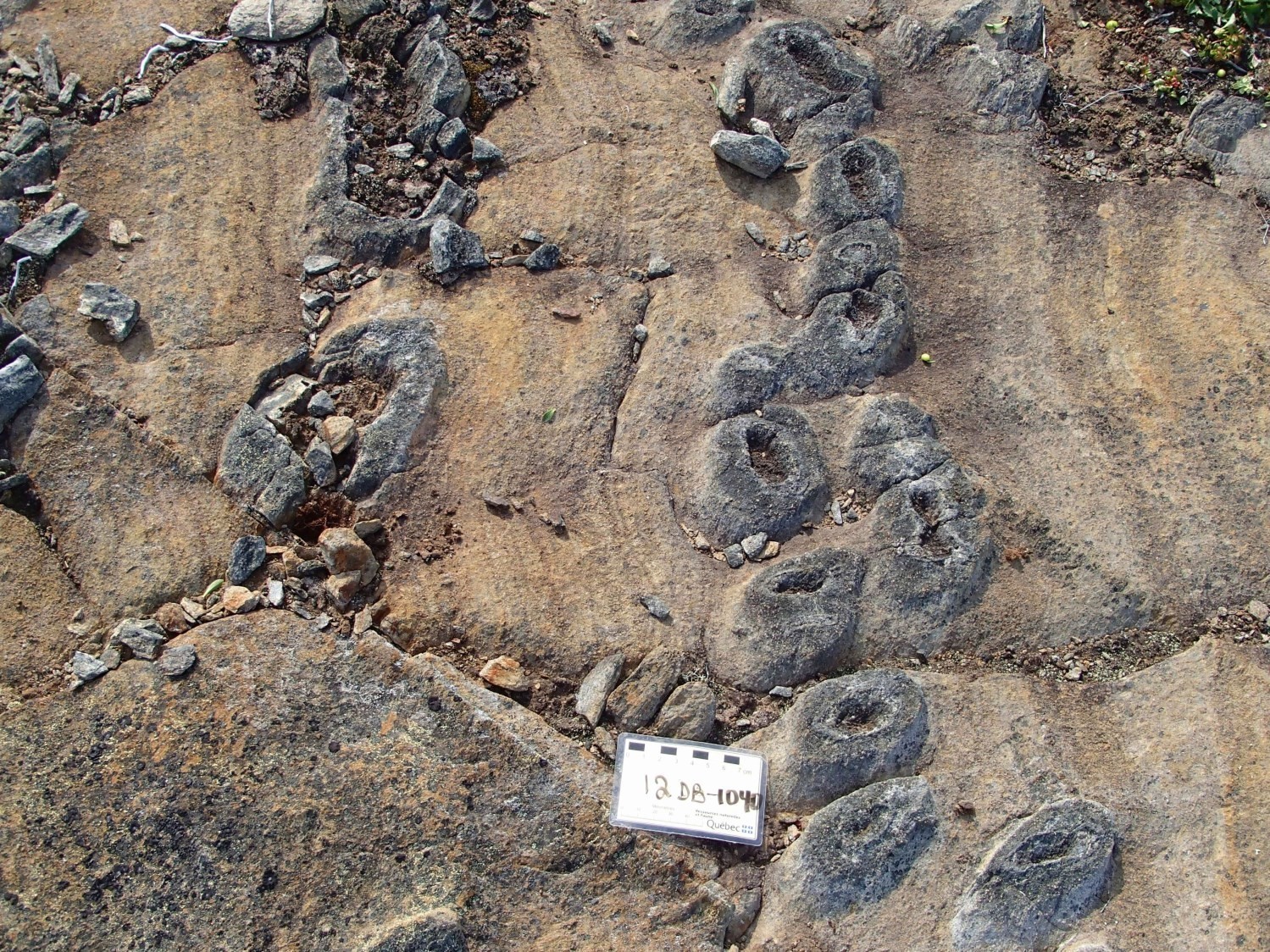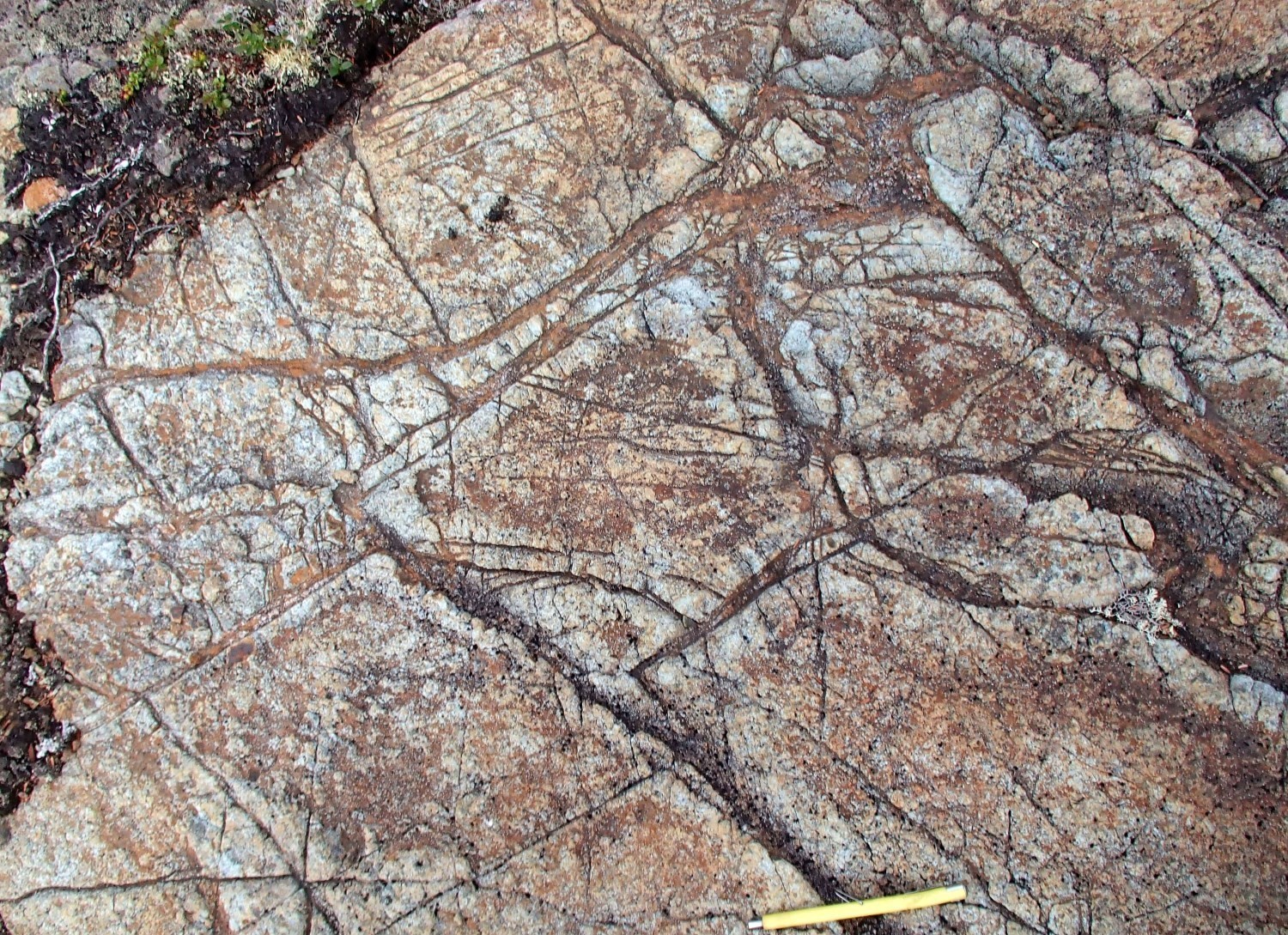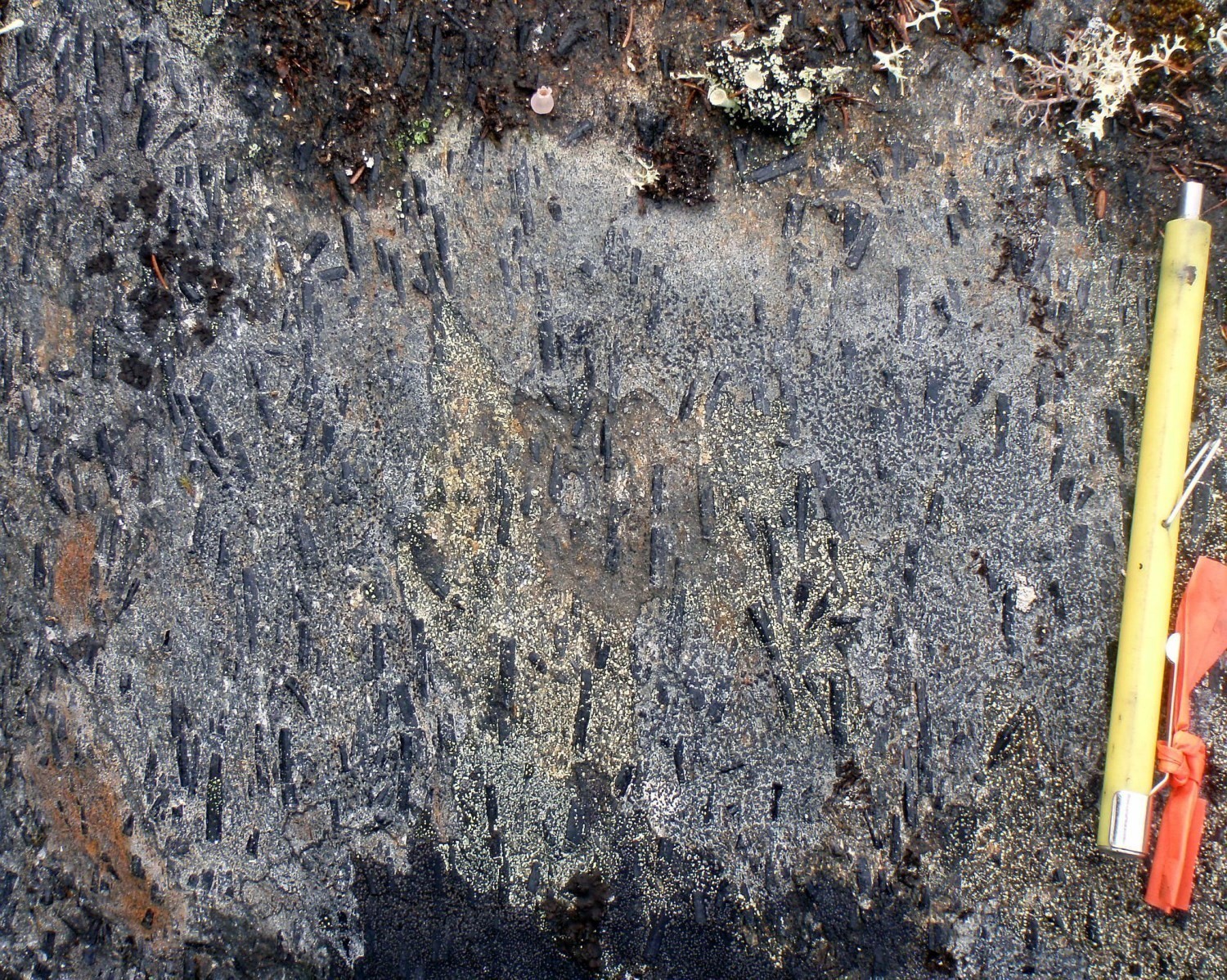
DISCLAIMER: This English version is translated from the original French. In case of any discrepancy, the French version shall prevail.
| Author(s): | Simard et al., 2013 |
| Age: | Paleoproterozoic |
| Stratotype: | None |
| Type area: | Kuujjuaq and Ungava Bay area (NTS sheet 24K) |
| Geological province: | Churchill Province |
| Geological subdivision: | Rachel-Laporte Lithotectonic Domain |
| Lithology: | Amphibolite |
| Category: | Lithodemic |
| Rank: | Suite |
| Status: | Formal |
| Use: | Active |
- Laporte Supersuite
- Préville Suite
- Klein Suite
- Freneuse Suite
- Secondon Suite
Background
The Klein Suite was introduced in the Kuujjuaq and Ungava Bay area (Simard et al., 2013) to group all metamorphosed mafic and ultramafic rocks of the Laporte Supersuite. The Laporte Supersuite includes Paleoproterozoic volcano-sedimentary rocks of the Rachel-Laporte Lithotectonic Domain, which represents the eastern part of the New Quebec Orogen. The Klein Suite was continued southward in the Saffray Lake (Lafrance et al., 2014) and Jeannin Lake (Charette et al., 2016) areas. Units of the Klein Suite were also standardized southward to the Griffis Lake area (sheet 23P04), as part of a synthesis of the Southeastern Churchill Province (SECP; Lafrance et al., 2018). Bilodeau (2018) also mapped the Klein Suite in the Kuujjuaq area.
Mafic rocks now assigned to the Klein Suite were first mapped by Sauvé (1957, 1959), Gélinas (1958a, 1958b, 1959), Fahrig (1964), Dimroth (1966), Dressler (1974, 1979), Baragar (1967), Frarey (1967), Penrose (1978), Clark (1978, 1980) and Girard (1995). These observations were incorporated into the SIGÉOM compilation map by Thomas Clark between 2009 and 2016 and used to supplement the description of several units. Units have been standardized as part of a synthesis of the SECP (Lafrance et al., 2018; Lafrance and Vanier, 2021). In the Deborah Lake area (sheet 23P05), Girard (1995) assigned amphibolite, metatuff and gabbro units to the Deborah Formation. This unit has also been abandoned and the rocks mentioned are included in units pPkle1a, pPkle1b and pPkle3 of the Klein Suite, respectively.
Description
The Klein Suite groups Paleoproterozoic metamorphosed mafic and ultramafic rocks of the Rachel-Laporte Lithotectonic Domain. It consists of three informal units: 1) amphibolite and metabasalt (pPkle1); 2) metamorphosed ultramafic rocks (pPkle2); and 3) metagabbro and glomerophyric metagabbro. Intrusive units are most commonly conformable within amphibolites and metasedimentary rocks of the Laporte Supersuite. However, sharp crosscutting has also been observed in places.
Klein Suite 1 (pPkle1): Amphibolite and Metabasalt
Unit pPkle1 consists of four informal units: 1) fine to very fine-grained amphibolite, possibly of volcanic origin (pPkle1a); 2) massive or pillow metabasalt and mafic or intermediate metavolcaniclastics (pPkle1b); 3) highly altered carbonate-quartz amphibolite (pPkle1c), and 4) amphibolite associated with some paraschist (pPkle1d). The different authors who worked in the Rachel-Laporte Domain did not always distinguish these differences in composition or texture; therefore, some outcrops were assigned to the undivided amphibolite unit (pPkle1). Unit pPkle1 could therefore include some medium to coarse-grained amphibolite of possible intrusive origin similar to unit pPkle3. Very fine-grained amphibolite is interpreted as effusive in origin, while coarser-grained rocks may be intrusive in origin. Observed relationships between these two facies suggest that coarser-grained amphibolites may be sills associated with lava.
Klein Suite 1a (pPkle1a): Fine to Very Fine-Grained Amphibolite
Amphibolites of subunit pPkle1a are banded, massive or schistose, dark green or black grey and fine to very fine grained, rarely medium grained. Banding is caused by variations in ferromagnesian mineral content. In thin sections, these rocks are characterized by a well-developed oriented granoblastic texture. They are composed of small hornblende prisms (50-85%) aligned in a fine-grained matrix of plagioclase ± quartz crystals that fill the pores. In places, hornblende also occurs as poikiloblasts more or less orientated in foliation. Some samples also contain 10-25% intergrown actinolite crystal clusters. Actinolite also replaces hornblende or clinopyroxene (uralitization), which is only preserved locally.
Amphibolite has been affected by retrograde metamorphism of regional importance, but generally quite low. This interpretation is supported by the common presence of chlorite associated with hornblende, more or less sericitized plagioclase, and the presence of carbonate. The latter fills fracture filling or is interstitial, replacing hornblende or plagioclase. Biotite and garnet are less common, but represent up to 10% of the rock locally. Staurolite has also been recognized in amphibolites around the Rénia and Boulder complexes. Almost all samples observed in thin sections contains sphene, apatite and opaque minerals (ilmenite ± magnetite). Epidote, zircon, allanite, tourmaline and sulphides are also present as accessory phases.
Klein Suite 1b (pPkle1b): Massive or Pillow Metabasalt and Metavolcaniclastics
Subunit pPkle1b is similar to subunit pPkle1a, but is distinguished by the presence of layers where primary textures, such as pillows and vesicles, are preserved. Pillows are usually elongated in foliation and are 5 cm to 10 cm wide by 20 cm to 40 cm long. Due to deformation, stratigraphic polarities are generally impossible to determine. Layers of intermediate to mafic pyroclastic rocks and layers containing ovoid mafic fragments, which may represent pillows having hyaloclastic margins filled with quartzs, have also been described locally.
Klein Suite 1c (pPkle1c): Highly Altered Carbonate-Quartz Amphibolite
Klein Suite amphibolites are commonly cut by discontinuous and boudinaged carbonate or quartz veins. Amphibolites locally show strong carbonate and silica alteration in the form of lenses that, when sufficiently numerous, give the rock a brecciated texture. In the Bay aux Feuilles area, Sauvé (1959) recognized a unit of altered amphibolite that Simard et al. (2013) assigned to subunit pPkle1c.
Klein Suite 1d (pPkle1d): Amphibolite With Some Paraschist
Centimetric to metric layers of rocks belonging to various metasedimentary units of the Freneuse Suite are in places interstratified with amphibolites of the Klein Suite. Some areas with a larger proportion of these paraschist layers were assigned to informal subunit pPkle1d in the Bay aux Feuilles (Sauvé, 1959) and Thévenet Lake (Gélinas, 1958a) areas.
Klein Suite 2 (pPkle2): Metaperidotite and Metapyroxenite
Unit pPkle2 consists mainly of metaperidotite and, to a lesser extent, metapyroxenite. Metaperidotite is very fine grained, foliated, highly magnetic, and blackish grey or light green in fresh exposure and buffy brown in altered surafce. On outcrops, relics of cumulate olivine crystals (35-50%) are commonly distinguished, giving the rock a spotted appearance. This texture is hardly observable in thin sections, underlined only by the circular arrangement of fine magnetite grains. Primary minerals of metaperidotite are generally replaced by a fine-grained mixture of tremolite acicular or in or large felt clusters, chlorite in large masses of fine crystals or felt clusters, carbonate and serpentine (iddingsite and antigorite). Two types of chlorite are often present, pennine and prochlorite. More or less altered olivine and pyroxene crystals are preserved locally. In some areas, the ultramafic rock is transformed into a mixture of carbonate and talc and is not magnetic. Metapyroxenite is massive or foliated, fine to medium grained and dark green. It is mainly composed of large amphibole crystals (actinolite and hornblende) with some clinopyroxene (<10%).
Klein Suite 3 (pPkle3): Metagabbro and Glomerophyric Metagabbro
Metagabbro is homogeneous, non-magnetic, medium grained, massive, locally foliated or lineated. It is dark green or greenish grey, both in fresh exposure and altered surface. It generally contains 55-80% ferromagnesian minerals, locally more in some pockets or discontinuous layers of ultramafic composition. Compositional variations characterize some outcrops where tremolite-rich ultramafic rocks, melanocratic and leucocratic gabbros coexist. These different facies may correspond to multiple intrusive phases or are the result of magmatic differentiation within a single sill. Unit pPkle3 outcrops contain locally 1-2% millimetric to centimetric quartz ± calcite veinlets.
Metagabbro is mainly composed of large amphibole crystals (hornblende or actinolite) in a finer-grained and well recrystallized quartz ± plagioclase matrix. Clinopyroxene is locally preserved, but is generally partly or highly amphibolized. Hornblende occurs as large poikiloblasts, actinolite as rods. Secondary mineral phases are opaque minerals, sphene, apatite, zircon, chlorite, biotite and epidote with local carbonate and garnet.
In some places, metagabbro has a glomerophyric texture defined by 10-60% whitish porphyroblasts. These represent aggregates of small plagioclase crystals containing hornblende and anthophyllite rods displaying random orientation. Deformation of these textures is variable. Slightly deformed aggregates are rounded with a diameter <4 cm. With increased deformation, they take an oval or very stretched shape in foliation and are up to 10 cm long (Gélinas, 1956). This facies had already been described east of Gabriel Lake by Gélinas (1958b) and Sauvé and Bergeron (1965). In the Labrador Trough, Sauvé and Bergeron (1965) mention the presence of spotted (glomerophyric) gabbros, which can be equivalent to Klein Suite metagabbros, at the base of volcanic sequences of the Hellancourt Formation (Sauvé and Bergeron, 1965; Wares and Goutier, 1990; Clark and Wares, 2004).
In the Jeannin Lake area (Charette et al., 2016), a subophitic gabbro intrusion was observed west of Horseshoe Lake. The intrusion, which is ~4 km by 2 km, displays alternating subophitic gabbro and partially amphibolized gabbro similar to metagabbro described above. The subophitic facies is purplish grey, slightly magnetic in places and more leucocratic than the amphibolitized facies. Ferromagnesian minerals (40-50%) consist of unaltered clinopyroxene, and olivine highly replaced by a mixture of serpentine, chlorite and actinolite.
Thickness and distribution
The Klein Suite covers an area of ~1373 km2 within the Rachel-Laporte Tectonic Domain. Amphibolites of unit pPkle1 (including its subunits) is the dominant litholgy of the suite (1110 km2). They form layers and klippes up to 5 km wide, interstratified with metasedimentary units of the Freneuse Suite. Ultramafic rocks of unit pPkle2 unit and metagabbros of unit pPkle3 form hectometric to kilometric intrusions. On the eastern and northern edge of the Wheeler Complex, in the Jeannin Lake area, there are thicker amphibolite and metagabbro sequences that are nearly 10 km wide.
Dating
The ~1884 Ma preliminary age obtained in a coarse-grained gabbro sample is similar to those obtained in glomerophyric gabbro sills of the Gérido Intrusive Suite (Montagnais Supersuite), in the Labrador Trough. The ages obtained in the Gérido Intrusive Suite range from 1884 Ma to 1874 Ma (Machado et al., 1989; Findlay et al., 1995; Wodicka et al., 2005).
| Unit | Sample Number | Isotopic System | Mineral | Crystallization Age (Ma) | (+) | (-) | References (s) |
| pPkle3 | 15HUBM182 | U-Pb | Zircon | 1883.5 (preliminary) | 0.9 | 0.9 | Houlé et al., 2016 |
Stratigraphic Relationship(s)
Rocks of the Klein Suite are commonly observed alternating with metasedimentary rocks of the Freneuse Suite. Mafic (pPkle3) and ultramafic (pPkle2) intrusions are most often conformable with layers of amphibolite (pPkle1) and metasedimentary rocks (pPfru), but sharp crosscut has been observed locally (Lafrance and Vanier, 2021). The Klein Suite is also in fault contact with the various Archean complexes (thrust sheets) of the Rachel-Laporte Domain and Labrador Trough, namely the Boulder, Rénia, Highfall, Boullé and Wheeler complexes (Simard et al., 2013; Lafrance et al., 2014; Charette et al., 2016). The various units of the Klein Suite are locally intruded by granite and pegmatitic granite dykes or sills of the Mercier Suite.
Several authors have proposed that amphibolites of the Klein Suite are largely equivalent to volcanic rocks and sills of the Kaniapiskau Supergroup located in the Labrador Trough directly to the west (Harrison, 1952; Gélinas, 1958a, b; Sauvé and Bergeron, 1965; Simard et al., 2013). Specifically, in the northern part of the Rachel-Laporte Domain, unit pPkle1 amphibolites would be equivalent to lava and sills of the Hellancourt Formation (Sauvé and Bergeron, 1965; Clark, 1980), which is assigned to the Koksoak Group (Wares and Goutier, 1990; Clark and Wares, 2004). In the southern part, amphibolites would be partly equivalent to volcanic rocks of the Willbob and Murdoch formations (Doublet Group) recognized by Dressler (1979). Unit pPkle3 metagabbro would represent metamorphosed equivalents of intrusive rocks belonging to the Gerido Intrusive Suite (Montagnais Supersuite; Wares and Goutier, 1990; Clark and Wares, 2004), a unit consisting of mafic and ultramafic sills that have developed in different sedimentary and volcanic units of the Labrador Trough (Kaniapiscau Supergroup).
The work of Henrique-Pinto et al. (2017) rather suggests different depositional contexts between the Laporte Supersuite (Rachel-Laporte Domain) and the Kaniapiscau Supergroup (Labrador Trough). The Kaniapiscau Supergroup would have been deposited along an intraplate continental margin characterized by dominant recycled Paleoarchean sources, whereas the Laporte Supersuite would mark the transition from a continental fore-arc with a juvenile source to a sedimentation zone in the context of a collisional foreland peripheral basin (Henrique-Pinto et al., 2019). The ~1883.5 Ma age obtained in a gabbro of the Klein Suite indicates, however, that metasedimentary rocks of the Freneuse Suite (<1834 Ma; Henrique-Pinto et al., 2017) must also include an older sequence that hosted mafic sills older than 1834 Ma). It is possible that some of the rocks included in the Rachel-Laporte Domain may be rocks of the Labrador Trough that were tectonically imbricate within the Rachel-Laporte Domain (Lafrance and Vanier, 2021).
Paleontology
Does not apply.
References
Publications Available Through SIGÉOM Examine
BILODEAU, C., 2018. Géologie de la partie nord du Domaine de Rachel-Laporte, région de Kuujjuaq, Nunavik, Québec, Canada. MERN; CG-2018-07
CHARETTE, B., LAFRANCE, I., MATHIEU, G., 2016. Géologie de la région du lac Jeannin, Québec, Canada. MERN; BG 2015-01, 1 plan.
CLARK, T., 1978. REGION DU LAC HERODIER ( NOUVEAU-QUEBEC) – RAPPORT PRELIMINAIRE. MRN; DPV 568, 48 pages, 2 plans.
CLARK, T., 1980. REGION DE LA RIVIERE KOKSOAK (NOUVEAU-QUEBEC) – RAPPORT PRELIMINAIRE. MRN; DPV 781, 24 pages, 1 plan.
CLARK, T., WARES, R., 2004. SYNTHESE LITHOTECTONIQUE ET METALLOGENIQUE DE L’OROGENE DU NOUVEAU-QUEBEC (FOSSE DU LABRADOR). MRNFP; MM 2004-01, 182 pages, 1 plan.
DIMROTH, E., 1966. GEOLOGIE DE LA REGION DU LAC DUNPHY, TERRITOIRE DU NOUVEAU-QUEBEC. MRN; RP 557, 24 pages, 1 plan.
DIMROTH, E., 1966. PRELIMINARY REPORT, GEOLOGY OF DUNPHY LAKE AREA, NEW QUEBEC TERRITORY. MRN; RP 557(A), 21 pages, 1 plan.
DRESSLER, B., 1974. GEOLOGY OF THE NACHICAPAU HORSESHOE (1/6-SW), MARCEL, BUTEUX AND JOGUES (EAST HALF) LAKES AREAS, NEW-QUEBEC TERRITORY, PRELIMINARY REPORT. MRN; DP 269, 17 pages, 6 plans.
DRESSLER, B., CIESIELSKI, A., 1979. Région de la fosse du Labrador. MRN; RG 195, 136 pages, 14 plans.
GELINAS, L., 1958. RAPPORT PRELIMINAIRE SUR LA REGION DU LAC GABRIEL (PARTIE OUEST), NOUVEAU-QUEBEC. MRN; RP 373, 13 pages, 1 plan.
GELINAS, L., 1958. PRELIMINARY REPORT ON GABRIEL LAKE AREA (WEST HALF), NEW QUEBEC. MRN; RP 373(A), 11 pages, 1 plan.
GELINAS, L., 1958. RAPPORT PRELIMINAIRE SUR LA REGION DU LAC THEVENET (MOITIE EST), NOUVEAU-QUEBEC. MRN; RP 363, 11 pages, 1 plan.
GELINAS, L., 1958. PRELIMINARY REPORT ON THEVENET LAKE AREA (EAST HALF), NEW QUEBEC. MRN; RP 363(A), 8 pages, 1 plan.
GELINAS, L., 1959. REGION DU LAC GABRIEL (PARTIE EST) ET LA REGION DE FORT CHIMO (PARTIE OUEST), NOUVEAU-QUEBEC. MRN; RP 407, 13 pages, 1 plan.
GELINAS, L., 1959. PRELIMINARY REPORT ON THE GABRIEL LAKE AREA (EAST PART) AND THE FORT CHIMO AREA (WEST PART), NEW QUEBEC. MRN; RP 407(A), 10 pages, 1 plan.
GIRARD, R., 1995. GEOLOGIE DE LA REGION DU LAC DEBORAH, TERRITOIRE-DU-NOUVEAU-QUEBEC. MRN; MB 95-20, 186 pages, 3 plans.
LAFRANCE, I., CHARETTE, B., VANIER, M-A., 2018. Sud-est de la Province de Churchill, Nunavik, Québec, Canada: synthèse de la géologie. MERN; BG 2018-12
LAFRANCE, I., SIMARD, M., BANDYAYERA, D., 2014. GEOLOGIE DE LA REGION DU LAC SAFFRAY (SNRC 24F, 24G). MRN; RG 2014-02, 51 pages, 1 plan.
LAFRANCE, I., VANIER, M.-A. 2021. DOMAINE LITHOTECTONIQUE DE RACHEL-LAPORTE, SUD-EST DE LA PROVINCE DE CHURCHILL, QUÉBEC, CANADA : SYNTHÈSE DE LA GÉOLOGIE. MERN; BG 2021-01, 1 plan.
NADEAU, S., 2017. CARACTERISATION D’UN GABBRO A MEGACRISTAUX DE PLAGIOCLASE. UNIVERSITE DU QUEBEC A CHICOUTIMI; MB 2017-13, 50 pages.
PENROSE, B., 1978. GEOLOGIE DE LA REGION DU LAC HORSESHOE (NOUVEAU-QUEBEC). MRN; DPV 573, 39 pages, 1 plan.
SAUVE, P., 1957. RAPPORT PRELIMINAIRE SUR LA REGION DU LAC DE FRENEUSE (MOITIE EST), NOUVEAU-QUEBEC. MRN; RP 358, 10 pages, 1 plan.
SAUVE, P., 1957. PRELIMINARY REPORT ON DE FRENEUSE LAKE AREA (EAST HALF), NEW QUEBEC. MRN; RP 358(A), 8 pages, 1 plan.
SAUVE, P., 1959. RAPPORT PRELIMINAIRE SUR LA REGION DE LA BAIE AUX FEUILLES, NOUVEAU-QUEBEC. MRN; RP 399, 15 pages, 1 plan.
SAUVE, P., 1959. PRELIMINARY REPORT ON LEAF BAY AREA, NEW QUEBEC. MRN; RP 399(A), 11 pages, 1 plan.
SAUVE, P., BERGERON, R., 1965. REGION DES LACS GERIDO ET THEVENET, NOUVEAU-QUEBEC. MRN; RG 104, 141 pages, 3 plans.
SAUVE, P., BERGERON, R., 1965. GERIDO LAKE – THEVENET LAKE AREA, NEW QUEBEC. MRN; RG 104(A), 131 pages, 3 plans.
SIMARD, M., LAFRANCE, I., HAMMOUCHE, H., LEGOUIX, C., 2013. GEOLOGIE DE LA REGION DE KUUJJUAQ ET DE LA BAIE D’UNGAVA (SNRC 24J, 24K). MRN; RG 2013-04, 62 pages, 1 plan.
WARES, R., GOUTIER, J., 1990. SYNTHESE METALLOGENIQUE DES INDICES DE SULFURES AU NORD DU 57e PARALLELE – FOSSE DU LABRADOR – RAPPORT INTERIMAIRE – ETAPE III. IREM-MERI; MB 90-25, 104 pages, 2 plans.
Other Publications
BARAGAR, W.R.A. 1967. Wakuach Lake map-area, Quebec-Labarador (23 O). Geological Survey of Canada; Memoir 344, 174 pages. http://dx.doi.org/10.4095/123960
FAHRIG, W. F. 1965. Lac Hérodier, Québec. Geological Survey of Canada; Map 1146A (annotated map). http://dx.doi.org/10.4095/107520
FINDLAY, J.M., PARRISH, R.R., BIRKETT, T.C., WATANABE, D.H. 1995. U-Pb ages from the Nimish Formation and Montagnais glomeroporphyritic gabbro of the central New Québec Orogen, Canada. Canadian Journal of Earth Sciences; volume 32, pages 1208-1220. http://dx.doi.org/10.1139/e95-099
FRAREY, M.J. 1967. Willbob Lake and Thompson Lake map-areas, Quebec and Newfoundland (23O/1 and 23 O/8). Geological Survey of Canada; Memoir 348, 73 pages. http://dx.doi.org/10.4095/123896
FRAREY, M.J., DUFFELL, S. 1964. Revised stratigraphic nomenclature for the central part of the Labrador Trough. Geological Survey of Canada; Paper 64-25, 13 pages. https://doi.org/10.4095/123909
GÉLINAS, L. 1956. Les aplites à nodules dans la région de Fort-Chimo. Master’s thesis, Université Laval, Québec; 97 pages
GODET, A., GUILMETTE, C., LABROUSSE, L., DAVIS, D.W., VANIER, M.A., LAFRANCE, I., CHARETTE, B. 2020. Contrasting P-T-t paths reveal a metamorphic discontinuity in the New Quebec Orogen: insights into Paleoproterozoic orogenic processes. Precambrian Research, page 105675. http://doi.org/10.1016/j.precamres.2020.105675
HARRISON, J.M. 1952. The Quebec-Labrador iron belt, Quebec and Newfoundland. Geological Survey of Canada; Paper 52-20, 21 pages. http://dx.doi.org/10.4095/123923
HENRIQUE-PINTO, R., GUILMETTE, C., BILODEAU, C., McNICOLL, V. 2017. Evidence for transition from a continental forearc to a collisional pro-foreland basin in the eastern Trans-Hudson Orogen: Detrital zircon provenance analysis in the Labrador Trough, Canada. Precambrian Research, volume 296, pages 181-194. http://doi.org/10.1016/j.precamres.2017.04.035
HENRIQUE-PINTO, R., GUILMETTE, C., BILODEAU, C., STEVENSON, R., CARVALHO, B.B. 2019. Petrography, geochemistry, and Nd isotope systematics of metaconglomerates and matrix-rich metasedimentary rocks: implications for the provenance and tectonic setting of the Labrador Trough, Canada. Canadian Journal of Earth Sciences, volume 56, pages 672-687. http://doi.org/10.1139/cjes-2018-0187
HOULE, M., McNICOLL, V., CORRIGAN, D. 2016. Preliminary U-Pb Results from Mafic-Ultramafic Intrusions in the Labrador Trough: Stratigraphic and Metallogenic Implications. 2016 Churchill Workshop, Québec. Geomapping for Energy and Minerals (GEM-2); may 18th, 2016. Ressources naturelles Canada.
MACHADO, N. 1990. Timing of collisional events in the Trans-Hudson Orogen: evidence from U-Pb geochronology for the New Québec Orogen, the Thompson Belt and the Reindeer Zone (Manitoba and Saskatchewan). In The Early Proterozoic Trans-Hudson Orogen of North America (Lewry, J.F. and Stauffer, M.R., editors). Geological Association of Canada; Special Paper 37, pages 353-369.
Suggested Citation
Ministère de l’Énergie et des Ressources naturelles (MERN). Klein Suite. Quebec Stratigraphic Lexicon. https://gq.mines.gouv.qc.ca/lexique-stratigraphique/province-de-churchill/suite-de-klein_en [accessed on Day Month Year].
Contributors
|
First publication |
Isabelle Lafrance, P. Geo., M.Sc. isabelle.lafrance@mern.gouv.qc.ca (redaction) Mona Baker, P. Geo., M.Sc. (coordination); Thomas Clark, P. Geo., Ph.D. and James Moorhead, P. Geo., M.Sc. (critical review); Pierre Lacoste, P. Geo., M.Sc. (editing); Céline Dupuis, P. Geo., Ph.D. (English version); Caroline Thorn (HTML editing). |
|
Revision(s) |
Isabelle Lafrance, P. Geo., M.Sc. isabelle.lafrance@mern.gouv.qc.ca; Marc-Antoine Vanier, Jr. Eng., M.Sc. marc-antoine.vanier@mern.gouv.qc.ca (redaction) Mehdi A. Guemache, P. Geo., Ph.D. (coordination); Carl Bilodeau, P. Geo., M.Sc. (critical review); Simon Auclair, P. Geo., M.Sc. (editing); Céline Dupuis, P. Geo., Ph.D. (English version); Ricardo Escobar Moran (HTML editing). |



